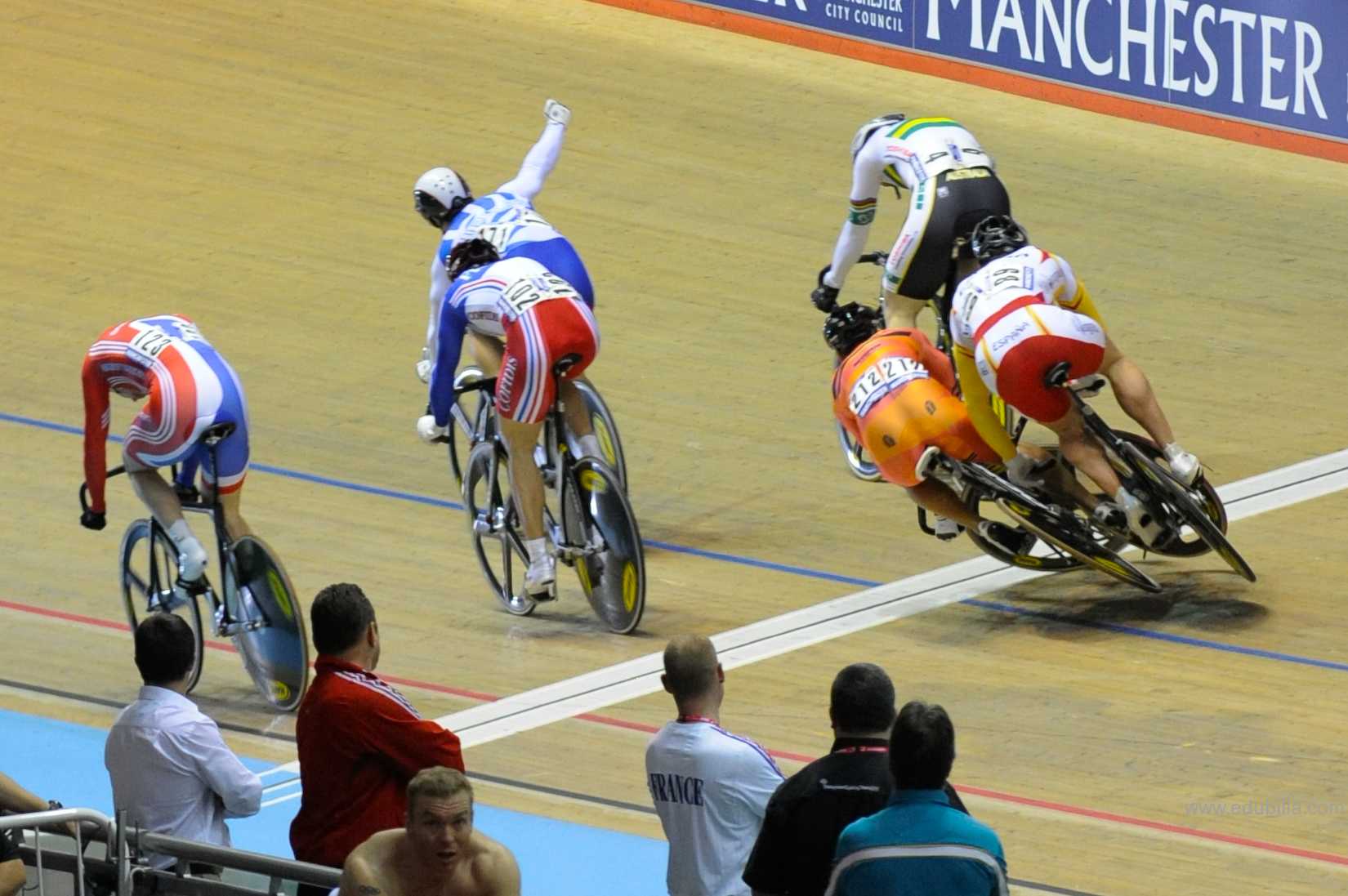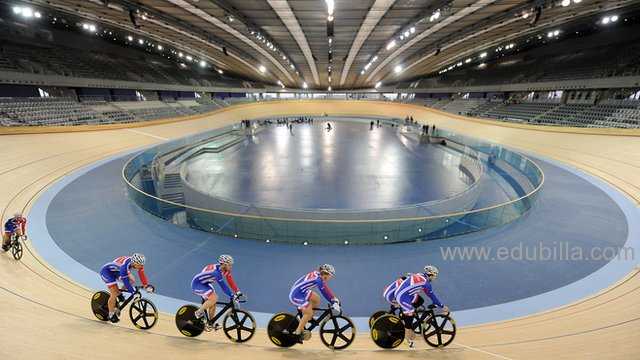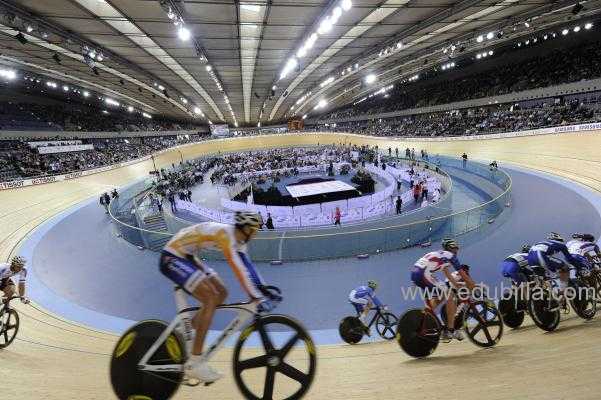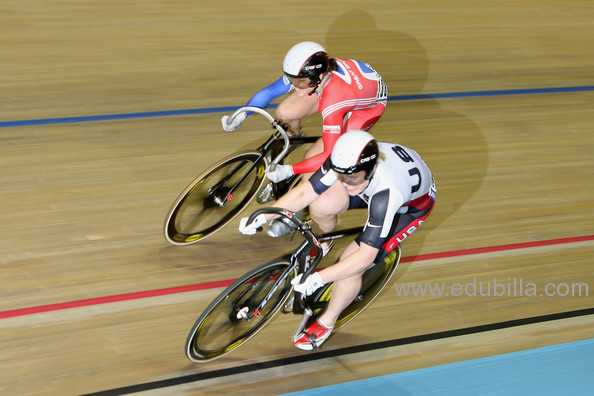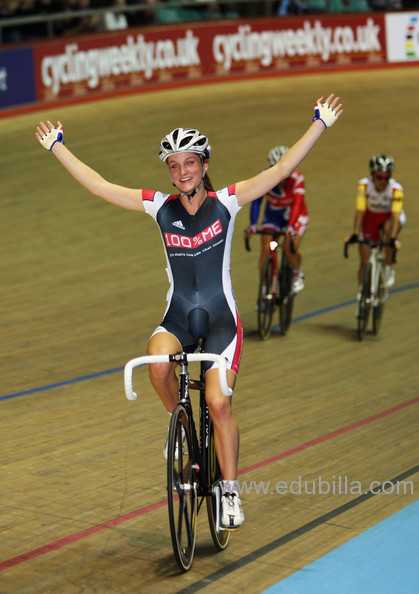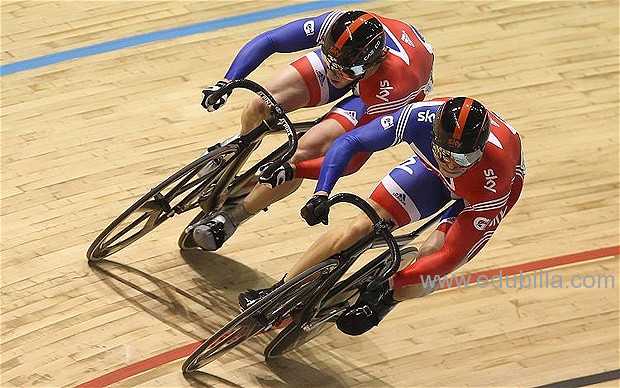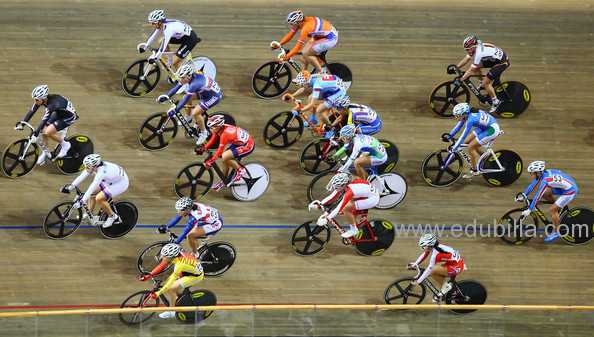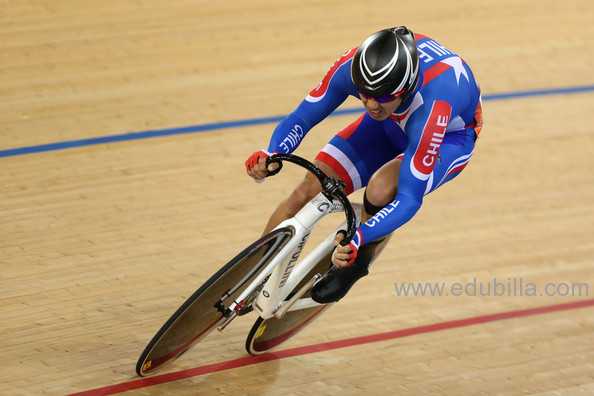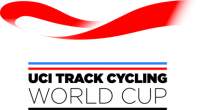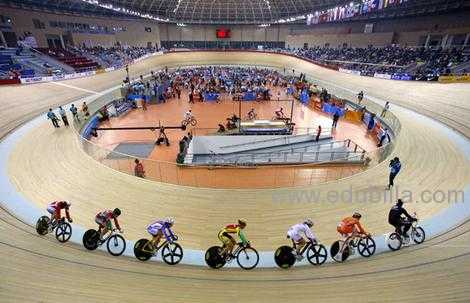
Overview Of Cycling track
Track Cycling is a bicycle racing sport usually held on specially built banked tracks or velodromes (but many events are held at older velodromes where the track banking is relatively shallow) using track bicycles.
World championships:
Records:
The original records were on the track: unpaced, human-paced and mechanically paced. They were promoted for three classes of bicycle: solos, tandems and unusual machines such as what are now known as recumbents, on which the rider lies horizontal. Distances were imperial and metric, from 440 yards and 500 metres to 24 hours.The UCI banned recumbents in competitions and in record attempts on 1 April 1934. Later changes included restrictions on riding positions of the sort that affected Graeme Obree in the 1990s and the banning in 2000 of all frames that did not have a seat tube.
Rainbow jersey:
The winner of a UCI World Championship title is awarded a rainbow jersey, white with five coloured bands on the chest. This jersey can be worn in only the discipline, specialty and category of competition in which it was awarded, and expires on the day before the following world championship event. Former champions are permitted to wear rainbow piping on the cuffs and collar of their clothing.
All Events In Olympic:
Men's Events:
Keirin men
Omnium men
Sprint indivual men
Team Pursuit (4000m) men
Team Sprint men
Women's Events:
Keirin women
Omnium women
Sprint women
Team Pursuit (3000m) women
Team Sprint women
Game Rules
As defined by UCI rules, the first round of competition used to qualify for the sprint competition is the flying 200 m time trial. In this round each rider completes two to three warm up laps and then completes the final 200 m, which is usually just under a lap. The number of riders that qualify for the sprint rounds depends on the competition; in World Cup competitions, 16 riders will advance and in a world championship, 24 riders will advance. The top riders are seeded in the following rounds, meaning the fastest qualifier will face the slowest qualifier and so on. Knock-out rounds then proceed, initially on a one race basis and then on a best-of three-race format from the quarter-final stage. Riders defeated in the earlier rounds may get a chance to continue in the competition through the repechage races.
SPRINT EVENTS
Match Sprint (Men/Women):
Traditionally held over 1000m, this event captures the essence of track cycling, although it is the most mysterious. Although it is normally a one-on-one event, earlier rounds can feature three or more cyclists on the track at the same time. One rider is designated to lead for the first lap (usually by a coin toss), and can not relinquish it unless those behind take it from him/her. The competitors typically eye each other off for the first 6-700 metres, trying to maneuver each other into an unfavourable position, before launching an explosive sprint for the last 200 metres, which is the only part of the event that is timed. The first across the line wins the race.
Tactics are the key to this race, and many people wonder why it is so slow for the first two laps. The main reason is that unless you can surprise your opponent early, you will waste too much precious energy in starting your sprint from lap one. If the other guy is on your wheel, it’s all over.
An important rule is that of ‘possession’ underneath the sprinter’s line, a line marked 80 cm from the pole line near the base of the track. A rider who positions themselves below this line in the final 200 metres is not allowed to be forced out by another rider e.g. pushing in from the inside. This is one of the most often broken rules causing reversals in sprint results.
1,000 m Time Trial (Men):
Probably the most painful of track disciplines, the “kilo” as it is known commonly is raced as a time trial over 1000 metres. To do well in this event you have to have an explosive start, good top speed, and endurance to carry you through the last few hundred metres where the lactic acid buildup in your legs becomes almost intolerable.
The current record is 58.875 seconds, by Arnaud Tournant of France, recorded on October 10, 2001. Tournant was the first rider to break the one minute barrier, lowering his own previous record of 1.00.148.
In this event, two riders often start on opposite sides of the track although it is essentially an individual event.
500 m Time Trial (Women):
Held over half the distance of the men, the women’s 500m time trial requires explosiveness as well as good top speed. Typically, the fastest 200m rider is also the best over 500, although this is not always the case. It is different to the men’s race with respect to the endurance required.
Olympic Sprint (Men):
A three man time trial held over three laps of the velodrome, with teams starting on opposite sides of the track. After the end of each lap, the leading rider pulls off completely, leaving the next to fight the wind. Therefore, the first rider has to do one laps, the second, two laps, and the last rider three laps. Hence, rider number three typically has the best endurance: A good kilometre time trial rider e.g. Arnaud Tournant or Shane Kelly is chosen for this position.
2000 m Keirin (Men):
The keirin is a motorpaced event that is very popular in Japan where it originated. In that country, huge amounts of money are bet on races and professional keirin riders command impressive salaries.
It is similar to the match sprint, but features 6-8 riders on the track. A derny motorbike paces the riders from 25 km/h up to 45 km/h for the first few laps. During this time, riders jostle each other for the best position and this is often the roughest part of the event. With two and a half laps to go, the derny bike pulls off and the sprint is on. Team tactics are important here, as the leadout is often quite long. If one team can get two of their riders in the final, then they are at a distinct advantage.
ENDURANCE EVENTS
Individual Pursuit (Men/women):
Held over 4000 metres for elite men and 3000 metres for elite women (shorter for masters riders), this is considered an “endurance” track event, although the speeds are still extremely high. Two riders start on opposite sides of the track and try to set the fastest time over the allotted distance. Normally, a qualifying time trial is ridden that determines who is eligible for the semi finals and finals. The fastest ride is often produced here, as in the finals, the only important criterion is to beat your opponent. If one rider catches the other, i.e. puts half a lap into them, then the race is over.
An explosive start is not critical (but it’s handy to have), however the ability to ride at a consistently high speed is far more important. Many riders who go out too hard can look to be well up on their opponent, only to fade in the last 1000 metres. This has typically the greatest “cross-over” to the road. i.e. good pursuiters make good road riders and vice versa. Stuart O’Grady, Vjatcheslav Ekimov, and Chris Boardman are a few examples of top pursuiters who have had successful road careers.
4000 m Team Pursuit (Men):
This event is raced by the men only, and held over 4000 m. Faster than the individual pursuit, although it is still an endurance event, the team pursuit is about clockwork precision as well as high speed. Two four man teams start on opposite sides of the track and try to set the fastest time over the distance as with the individual pursuit. The time taken is on the third rider to cross the line.
Riders must follow each other at a few cm difference to gain the maximum drafting effect from the rider in front. Following a wheel closely is a vital skill, but stuff-ups still happen, as the Ukrainian team showed at the 1997 Worlds in Perth. A wheel touch in the final brought down the whole team down and cost them the event.
Turns of pace are often half a lap, although the stronger riders can do full lap turns. The world record for this event was set by Germany in 2000 and is over 60 km/h!
60 km Madison (Men):
This race is named after Madison Square Garden in New York where the event was first held (also called “Americaine” in French. Two man teams contest the event, which is typically 50-60 kilometres. After a mass start where all riders are on the track, only one rider from each team is allowed in the race at a given time, meaning that teams must take it in turn each lap (or more) to have a rider in the race. Changeovers are quite dangerous, but impressive to watch when done well – one rider circles around waiting for his teammate, who joins hands and imparts his momentum to the slower rider.
To win the madison, the team must score points by sprinting every 20 laps for bonuses (5, 3, 2, 1 points). The last lap usually counts for double points, but the winner of this does not necessarily win the event. Also, if a team can gain a lap on the field, then they are in the leading position of the race no matter how many points they have.
Points Race (Men/women):
This is a solo event, scored similarly to the madison and raced by both men and women. Again, a rider scores points in intermediate bonus sprints every 10th lap (5, 3, 2, 1) with double points usually awarded on the last lap. If a rider can lap the field, then they get 20 points, which can be enough to secure the win – but not always. If a rider drops back a lap, they will have 20 points deducted from their total, so you sometimes see riders with negative scores.
Equipments Need For Cycling track
Pursuit of Cycling
Bicycle pants
Chainring:
A large toothed ring (part of the chainset) that drives the chain via the pedals and cranks.
Chainset:
The setup comprising the chainwheels, chain and rear sprocket.
Chainstay:
The two horizontal parts of the bike frame that join the bottom bracket to the rear wheel.
Cogwheel:
A less commonly used term for a sprocket.
Cranck:
The arms which drive the chainwheels. Cranks are bolted to the crankshaft.
Cranckshaft:
The axle to which the cranks are attached.
Gloves
Handlebars:
The part of the bicycle which the rider takes hold of.
Helmet
Saddle:
The seat of a bicycle.
Toe Strap:
A strap on a pedal which holds a foot in place.
History Of Cycling track
Cycling on wooden indoor tracks regularly drew large crowds as early as 1870 and was included in the inaugural Olympics Games.
Wooden indoor tracks:
As early as 1870, track races in England were regularly attracting large crowds. The riders competed on wooden indoor tracks that closely resembled the modern velodromes of today. Such tracks ensured the event could be competed all year round. But for promoters there was an even greater benefit – spectators could be charged an entrance fee!
Olympic history:
Track cycling events have been organised at all the editions of the Games since 1896, with the exception of the 1912 Games in Stockholm, when only the road race was staged.
Between 1924 and 1992, the range of events was generally as follows: sprint, time trial over one kilometre, tandem and team pursuit. The individual pursuit was added to the programme of the 1964 Olympic Games in Tokyo, and the tandem was dropped after the 1972 Games in Munich.
Women have competed in the track events since the Seoul Games in 1988, the year that marked the appearance of women in the sprint event, followed by the individual pursuit in 1992. At the Sydney Games in 2000, several track events were introduced: 500m time trial for women, but also keirin, American and sprint for men.
Origin Of Cycling track
The sport of bicycle racing has been around since the earliest days of the velocipedes of the 19th century.
Track Cycling has been around since at least 1870. When cycling was in its infancy, wooden indoor tracks were laid which resemble those of modern velodromes, consisting of two straights and slightly banked turns.
First recorded race:
The invention and development of the pneumatic tire was a significant development in bicycle racing and the first recorded race using pneumatic tires was held in 1889. Safety bicycle design, pneumatic
tires, and the principle of gearing combined to bring bicycle racing to a new level of competition, and soon these bicycles racing on banked wooden tracks became the sensation of the sporting world.
First Women's track cycling:
Women's track cycling was first included in the modern Olympics in 1988.
Cycling at the 1912 Summer Olympics:
The cycling events at the 1912 Games were limited to a road race around Lake Mälaren, which had already been a successful route for a yearly cycling race.Although not originally in the schedule, several
countries requested that track cycling be added;however, the organizing committee stuck by their plans not to build a new track cycling stadium as the only one in Stockholm had been destroyed in order for the Olympic Stadium to be built.
Governing Bodies
Union Cycliste Internationale(UCI):
The Union Cycliste Internationale is the world governing body for sports cycling and oversees international competitive cycling events. The UCI is based in Aigle, Switzerland.
The UCI issues racing licenses to riders and enforces disciplinary rules, such as in matters of doping. The UCI also manages the classification of races and the points ranking system in various cycling disciplines including mountain biking, road and track cycling, for both men and women, amateur and professional. It also oversees the World Championships.
The History of UCI at a Glance:
The UCI was founded in Paris in 1900, and its headquarters are now located at the UCI’s World Cycling Centre in Aigle, Switzerland.
1893: First Track World Championships.
1896: First modern Olympic Games. Cycling is included in the programme.
14 April 1900: Foundation of the Union Cycliste Internationale by the Belgian, French, Italian, Swiss and United States National Federations in Paris (FRA).
1921: First Amateur Road World Championships.
1927: First Professional Road World Championships.
1950: First Cyclo-Cross World Championships.
1956: First Indoor Cycling World Championships.
1965: Creation of the International Amateur Cycling Federation (FIAC) and the International Professional Cycling Federation (FICP). The UCI became the coordinating body for these two federations. The FIAC was established in Rome (ITA), the FICP in Brussels (BEL).
1969: On July 1st, the UCI headquarters are transferred from Paris (FRA) to Geneva (SUI).
1977: The FICP headquarters are transferred from Brussels (BEL) to Luxemburg (LUX).
1982: First BMX World Championships.
1984: First Trials World Championships.
1990: First official Mountain Bike World Championships.
1992: Reunification of FIAC and FICP within the UCI. On November 1st, the Federation moves to Lausanne (SUI). On December 16th, inauguration of the new UCI headquarters in Lausanne.
1993: First official BMX World Championships.
1996: The mountain bike becomes an Olympic sport.
14 April 2002: Inauguration of the new UCI headquarters in Aigle (SUI).
2008: BMX becomes an Olympic sport.
To Visit UCI Click Here.
Awards Related To Cycling track
CYCLING AUSTRALIA AWARDS:
PEOPLE'S CHOICE AWARD
COACHING AWARD
CYCLING AUSTRALIA NATIONAL COACH OF THE YEAR
COACHING PROGRAM OF THE YEAR
CYCLING AUSTRALIA MEDIA AWARD
KEITH ESSON AWARD:
The late Keith Esson was a country print journalist with a passion for cycling. Not only did he cover cycling for decades for the Shepparton News but he was often found helping out with time keeping, driving in the convoy or holding forth in the pub educating experts and novices alike. He loved the international nature of the sport but he always championed the local heroes. The Keith Esson award is presented to an individual or organisation in recognition of their support of Australian domestic cycling.
CYCLING AUSTRALIA BEST YOUNG MEDIA TALENT AWARD
STATE/CLUB AWARDS
SUBARU NRS AWARDS
VOLUNTEER OF THE YEAR AWARDS
ACT VOLUNTEER OF THE YEAR AWARD
NSW VOLUNTEER OF THE YEAR AWARD
NT VOLUNTEER OF THE YEAR AWARD
QLD VOLUNTEER OF THE YEAR AWARD
SA VOLUNTEER OF THE YEAR AWARD
TAS VOLUNTEER OF THE YEAR AWARD
VIC VOLUNTEER OF THE YEAR AWARD
WA VOLUNTEER OF THE YEAR AWARD
BMXA VOLUNTEER OF THE YEAR AWARD
MTBA VOLUNTEER OF THE YEAR AWARD
Sample Documents Of Cycling track
-Michael Jordan

